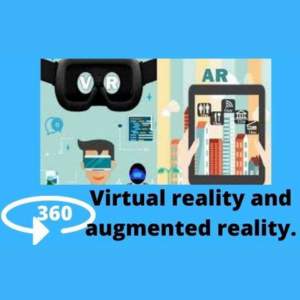What is virtual reality and augmented reality? VR and AR are profoundly in trend nowadays. Augmented Reality (VR) headset innovation was created in 1968. Ivan Sutherland, a PC researcher, and Weave Sproull, one of his understudies made it.
You can associate with the world by utilizing VR goggles or different devices. Magnetometers and gas pedals are utilized in augmented simulation. Picks how to collaborate with a virtual region through a headset. The climate notices the expanded reality (AR). The client has command over his actual presence.
Clients of VR, then again, are under framework control. So you can utilize your cell phone to get to it utilizing (AR).AR works on both virtual and actual properties. AR is a helpful device for deciphering and interpreting unknown dialect content. Guests to authentic areas get continuous data on account of increased reality.
Augmented Reality and Virtual Reality

With increased reality (AR), you can notice live perspectives on a cell phone because the application capabilities as computerized components yet in addition joins computer-generated reality and expanded reality advancements.
Generally, expanded the Truth is a product program that joins sound and video content. The following are a couple of cases of AR The US Armed Force, Ikea versatile application, Lookator, Spot Wrongdoing, L’Oreal excellence application, Across Air, Google Sky Guides, Disney shading books, and Weather conditions Station impacts application are only a couple of models.
You can interface this muddled, large, and weighty gadget to a PC. With time, it has come to be known as the sword of Damocles and misses the mark on camera. Augmented reality innovation establishes a climate utilizing PC-based innovation.
These are things that appear as though they have a place in reality. For example, clients of this innovation experience a feeling of drenching here. The following are three essential sorts of computer-generated experience. For example, VR can be knowledgeable in three unique ways that are not the slightest bit, a tad, and completely.
Options for Google VR and AR
The connection between the genuine world and the advanced world is made using virtual and expanded reality. You can participate in routine exercises like data perusing, buying, and so forth utilizing AR. An application for Dream and Cardboard is Google VR. So you can acquire information about numerous areas and experience living there. Clients of this application get help in various ways. Google has created various VR and AR parts and products. Here are a few notable models.
Google Cardboard
Google Cardboard is a direct and savvy VR stage. It has a cardboard watcher that can overlay and oblige a telephone. So clients can get to basic VR content and energetic 360-degree recordings that utilizing the Google Cardboard application and other reasonable VR applications.
Google Dream
Google’s virtual reality platform, Dream, offers a more sophisticated VR experience. It comes with a trend control and an inviting VR headgear. With Dream, users may enjoy a vast selection of VR games, experiences, and applications from the Google Play Store.
The Google Campaigns
Undertaking the VR stage is an instructive one. It empowers instructors to lead understudies on virtual field trips utilizing VR headsets. Google’s expanded reality stage for Android gadgets is called AR Core. Adding state-of-the-art content to this ongoing reality empowers designers to make increased reality encounters.
It utilizes the gadget’s camera, and sensors, and deals with abilities to follow the ongoing climate. Google Point of Convergence is a visual chase device controlled by the expanded reality that can be found in the Google Photographs application and Google Accomplice. Since it can understand text, articles, and achievements utilizing the camera on the gadget.
Google Guides Live View
Live View is an augmented reality feature encompassed in the Google Guides app. To offer a uniform AR route, bearings are superimposed over the camera viewpoint on the surrounding elements.
What distinguishes VR and AR from one Another?
Computer-generated reality (VR) and augmented reality (AR) are the two technical advancements that offer life experiences. However, their approaches to the reality we live in now are different.
Computer-generated Reality (VR)
By covering their ears and eyes with a VR helmet, clients shut out the outside world. The VR headset enables the user to feel fully submerged in the virtual world since the virtual world display reacts to their motions. The virtual world frequently calls for controllers and other informative devices to function.
Increased Reality (AR)
By adding virtual content on top of the real world, AR improves it. Thanks to augmented reality technology, customers may interact with virtual things while still being aware of their surroundings. This is usually possible with devices like mobile phones or tablets, which use the camera to record this current reality and display virtual content on the screen. With certain AR glasses or headsets, this is also achievable.
While VR generally provides a completely recreated digital environment that users may interact with. AR combines virtual and real-world aspects, allowing users to interact with virtual things while maintaining awareness of their real-world surroundings, in contrast with VR, which seeks to fully immerse users in a virtual environment.

